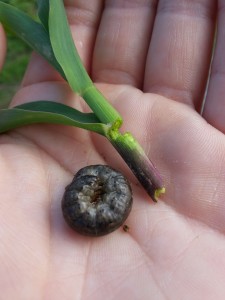
In this photo you see what is called a stalk borer. It will get into the stalk of corn and eat through it at the bottom. You can tell that you have these by having wilting whorls but the rest of the plant will be fine. If you pull out the wilted whorl and unroll it you will either find the feeding or the borer itself.
AGRONOMIC CROPS:
VEGETABLES:
FRUIT:
AGRONOMIC CROPS:
VEGETABLES:
FRUIT:

This is the type of damage a black cutworm can do. In the photo is a cutworm that is near, or already in it’s last instar, being the 7th. The cutworm is being compared to a V2 stage corn stalk that is somewhere between 2 and 3″ tall. The cutworms like the smaller corn because it is easier for them to shew through. Once they have chewed through the stalk they will then carry it back to their hole, which is where one of the scouts dug this one from. These shouldn’t be around much longer considering the size of this guy but it’s just something to watch for.